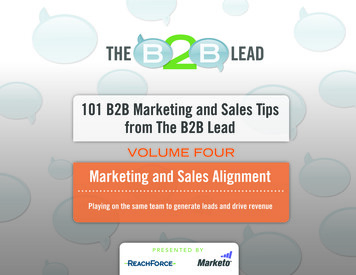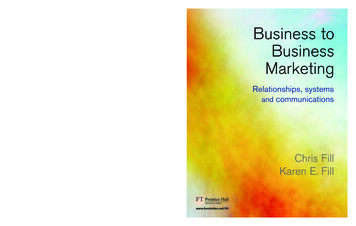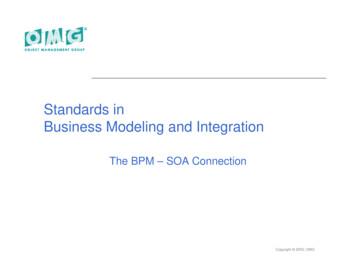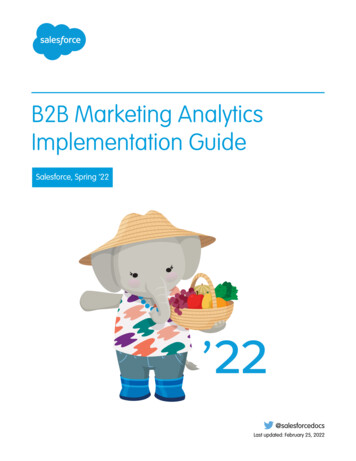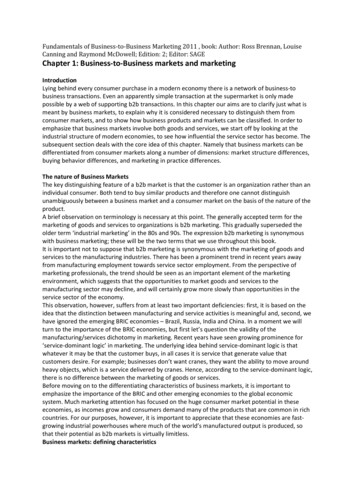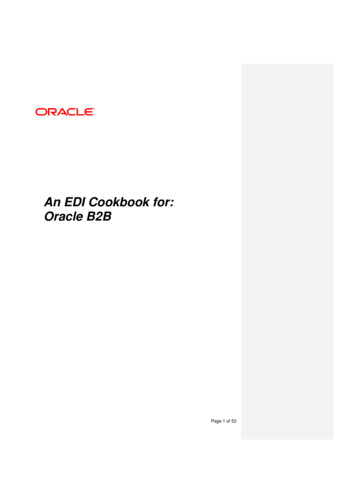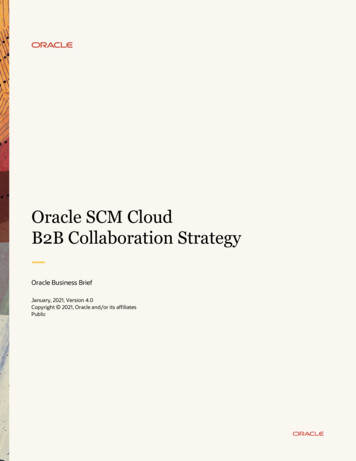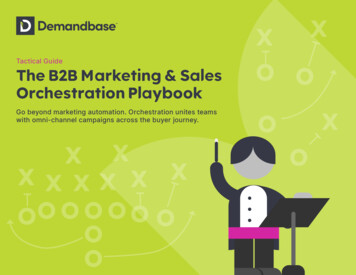
Transcription
XXTactical GuideThe B2B Marketing & SalesOrchestration PlaybookGo beyond marketing automation. Orchestration unites teamswith omni-channel campaigns across the buyer journey.X XX X XX X XOO O O O O OOOO OXOO
Selling in the Modern B2B World(Many players. One heartbeat.)It’s official.The buyer’s world has gone digital. And thereis no turning back.Deloitte notes this phenomenon as “life onthe cloud,” where, in 2020 (thanks to theCovid epidemic), the archetypal consumer’sjourney sharply shifted to a diverse world ofonline experiences like e-commerce, socialnetworking sites, and live influencers.1B2B buyers have access to virtually everybusiness solution on the planet. Dozens, if nothundreds, of solutions are just seconds awayfrom a few strokes on their keyboards.Every buyer — even B2B buyers, not justthe B2C — wants a seamless, personalizedexperience. Think the likes of Netflix andSpotify (the usual suspects). What’s more, B2Bbuyers expect bespoke buying experiencestailored specifically to their interests andneeds that combine those digital experienceswith traditional experiences like direct mail,phone calls, and live events.But with the complex buying cycle of B2B, howdo you, the B2B brand, provide the requisitecustom experience for all of your targetaccounts? After all, the last thing you want todo is spam buyers with unwanted, irrelevantmessages.The answer lies inDemandbase Orchestration.So here’s how this eBookcan help.Demandbase Orchestration makes your go-tomarket (GTM) strategy better by helping youget smarter about your outreach.We dig into how orchestration helps salesand marketing sell more effectively, someorchestration best practices, and howmarketing teams can quickly set up Audiencesand Automations using DemandbaseOrchestration.Because rich data and Account Intelligencefuel Demandbase One, you not only reachyour contacts and accounts in a personalizedway, but you reach the right accounts duringthe magical moments — at the right time intheir journey. In other words, you apply nextlevel ABM, which considers every part ofthe buyer journey. We call it account-basedexperience (ABX).By adding orchestration, you ensure thatthe moving parts in an ABX program aresynchronized across your organization’scustomer-facing teams. So you all work inlock-step to ensure a buyer’s experience ispositive, consistent, and in context with therest of the account.Plus, there’s a whole section dedicated toactual orchestration plays, so if you’re acampaign leader, you don’t have to build themfrom scratch.So where is your conductor’s baton? Pick it upbecause it’s time to start orchestrating!XMusic to your ears, right?OO2
What’s InsideXXX X X X X XOO O O O O OOOCHAPTER ONEA brief history from automation to orchestration,or the old strategies kind of suck. 4CHAPTER TWOWhat Is orchestration?. 8CHAPTER THREEThree orchestration best practices. 11CHAPTER FOURDo it right with Demandbase Orchestration. 15FINAL THOUGHTSNothing wrong with a little ROI brag. 25APPENDIX20 orchestrated plays. 26Orchestrate a smarter omni-channel campaign worksheet. 543
CHAPTER ONEA brief history from automation to orchestration,or the old strategies kind of suckBefore we enter the orchestration world, let’s (happily)look at all we’ll leave behind.As we are keenly aware, digital opportunities come with unique challenges whenselling in the B2B world. With all the information available to our accounts, we needto find ways to be seen and stay relevant across complex buying cycles. Acrossour marketing, sales, and customer teams, we’re all eager to do our part to win overthe next happy customer.The Traditional Sales FunnelLEADSMarket focuses oncreating leads.MQLOver the years, our tactics have (thankfully) improved. Let’s explore.The Advent of Marketing AutomationSQLAt the turn of the century (wow, most of us can actually say we’ve been aroundto see a century turn!), campaign management tools like Xchange came onto thescene. Marketing teams could use this new software to streamline direct mail andeventually email campaigns.OPPWe soon realized that wasn’t enough. These first campaign management platformswere built for a B2C world and were expensive and hard to implement, and we B2Bfolk were left in the cold. Until we weren’t.Enter Jon Miller (and others), who created the first SaaS marketing automationplatforms for the B2B world, like Marketo and Eloqua. Amazing!And yet It still wasn’t enough. Despite all its benefits, marketing automation helpedreinforce a demand generation world built around automated email and themarketing qualified lead (MQL). Unfortunately, the sales teams were rightlyfocused on selling to accounts, not leads, and we didn’t see much improvement insales and marketing alignment.Sales focuseson pipeline.CLOSEUpsell/Cross-sellCustomer teams deepen the customer experience.In the marketing automation world, we suffered from two not-so-greatapproaches: the hand-off and the omni-channel fumble.While we explore these approaches in the following pages, consider: Do yourteams fall into one of them?XO44
The hand-offXOIn the hand-off, marketers and sales reps stick to their siloed camps.Marketing owns the top of the funnel, generating leads — which they pass to sales,who in turn, owns the deal close and post-sale growth. This interaction resembles abaton pass in a relay race.But here’s the problem. Marketing tends to invest heavily in top-of-funnel tacticssuch as inbound marketing, leaving little support for critical deals in later stages.In fact, many sales teams ask marketing to shut off all nurturing to later-stageaccounts, not trusting their impersonal campaigns to help them close importantdeals.But the longer the sales cycle, the more likely it is that deals get stuck andabandoned in the sales and marketing hand-off. As they say, accidents happen atthe intersections.This causes potential deals to wither away on the vine, as they lack the attentionthey need to move forward.XO5
The omni-channel fumbleOn the other end of the spectrum, there are no prescribed divisions between therevenue teams, causing outreach efforts to overlap.But we get it. This doubling, sometimes tripling, up of motions across teams istotally understandable.SocialnetworkThe B2B buyer journey is complex and non-linear. The account will often moveits position in the funnel multiple times based on changes in its decision-makingjourney. Synchronizing efforts across this convoluted path can feel daunting, if notimpossible.RetainBuyingcommitteeresearchStart hereInitialresearchCustomerNot hereSocialmediaFirst websitevisitForm fill/Hand-raise/Demo requestPipelineResearch additionalsolutionsEvaluationCompetitivesite visitsUnknownBut the overlap in outreach can lead to tragic consequences, as revenue teamsomni-spam contacts with redundant, disconnected messages, annoying ratherthan befriending the buyer.KnownWe’re talking about a cacophony of digital invitations, offers, and meeting requestscoming through a deluge of marketing emails, sales cadences, social posts,LinkedIn messages, phone calls, and so on.“Companies with omnichannel customer engagement strategies retain onaverage 89% of their customers, compared to 33% for companies with weakomnichannel customer engagement.”— Business 2 Community26
Then came orchestrationFor a solid ten years, this is where B2B teams have lived, in a world of one-toomany siloes and fumbles with limited automation. Doing the best we could, but still.So the intractable innovators went at it again (yes, Jon Miller and also ChrisGolec) to form the first account-based marketing (ABM) platforms to lead B2Bteams into a modern world.A revolutionary approach to selling, ABM allows teams to identify B2B buyingcommittees at companies and surround each buyer with personalized messaging.But we were just getting started.Since then, we’ve expanded ABM to address the entire customer lifecycle, whichwe’ve coined ABX (account-based experience). ABX considers not just intent andawareness but also retention and expansion stages for a Smarter Go-To-MarketTMstrategy.With an ABX lens, we focus on the needs of all customer-facing roles, includingsales reps, sales enablement, post-sales, and account executives.With Demandbase Orchestration, sales and marketing teams can build dynamicjourney-based audiences as well as automated actions and processes across manypopular revtech and martech channels, freeing you from manual, time-consumingtasks.With all that free time, whatever shall you do?XOXXOTo that end, we’ve partnered with MAPs; CRM; social tools like LinkedIn andFacebook; direct mail and gifting providers like Sendoso, PFL, and Alyce; and salesengagement platforms like Outreach and Salesloft. We link these platforms toDemandbase Orchestration for audience management and workflow automationsthat encompass much more than traditional marketing automation.XO7
CHAPTER TWOWhat is orchestration?Orchestration is the coordination of activities, programs,and campaigns across the entire revenue team. Itempowers revenue teams to design and automate highimpact account-based plays across all your channels,including advertising, sales engagement, marketingautomation, direct mail, and chat.Crafted by marketing. Approved and used by sales.With orchestration, sales can maintain control of their high-value accounts whilemarketing coordinates and plans touches executed by front-line teams. And whilemarketers can nurture deals in a personalized, relevant, and contextual way,nothing is sent to an account without a salesperson approving it.Orchestration enables the one-on-one interaction required to build relationshipswith prospects and ensure success with customers. It works because it fostersauthentic human engagement.“Orchestration is the sequenced coordination of different activities, programs, andcampaigns across marketing, sales development, sales, and customer success todrive engagement with multiple stakeholders in target accounts.” - TOPO3XX With orchestration, programs are: Account-based and operationalized at scale. Team-based, increasing revenue team alignment (including marketing, sales,and customer success). Personalized to each buyer at the most valuable accounts. Relevant to the key contact in the account. Extended throughout the entire lifecycle of the account, from acquisition toadvocacy.XOOOOX8
What is orchestration? cont.Examples of insight-driven orchestration Sharing validation content such as customer reviews for accounts that are inthe late Opportunity stage.Orchestration can’t exist without segmentation, and segmentation relies on dataand insights. Here are some examples of orchestration, which use everything youknow about an account to increase your chances of engaging with them. Inviting engaged executives from high-intent accounts to a VIP experience. Customizing the website based on the account’s key investors (showing thatother portfolio companies are your customers is a strong form of social proof). Recommending content that shows how your solution works with the specifictechnologies they already own. Changing the advertising message as an account moves through the journey. Launching a targeted direct mail for highvalue accounts that show intent but noengagement. Alerting sales reps about highly engaged accounts that they haven’t alreadyreached out to.XXOOOThe sweetest part about orchestrations like these: You can automate them inDemandbase Orchestration (using the Audiences feature), freeing up your teams’workflows so they can focus on selling not time-consuming processes.X9
Up your game with orchestration playsA play is a series of synchronized orchestrations (both human and automated)across departments and channels.The “play” is the perfect metaphor for orchestration since it reflects that there aremultiple people at the target account and multiple people at your company workingtogether to interact with the account.We like to use the football chalkboard as an analogy. As in football, multiple peopleon your team line up to engage multiple people on the account team, and the playis a way of orchestrating who does what and when.Plays are a great way to effectively ensure that everyone in the companyconsistently follows best practices throughout their account work.Twenty orchestrated plays for the win!Check out the appendix for 20 examples of orchestrated plays across thebuyer journey. Use Demandbase Orchestration to help you execute yourplays seamlessly for some killer passing yards and touchdowns.XXX X X X X XOO O O O O OOOSolve your sales challenges and smash your goalsIn the complex buying cycles in the B2B world, orchestration offers a clear anddirect solution to nurturing deals from the top of the funnel to closed-won.Incorporate orchestration to: Shorten the sales cycle length. Increase deal size. Improve deal closure rates. (Fewer deals waste away in the limbo between theopportunity and closed stages.) Remove people in a deal that act as blockers and stall an opportunity. Improve renewal rates. Expand within key accounts by selling more or additional products. Realize greater marketing ROI.Every role benefits across revenue teams, including marketing and salesexecutives, field and enterprise marketers, revenue operations, sales development,and sales reps — really, any team member working on high-value accountinitiatives.10
CHAPTER THREEThree orchestration best practices1. Apply a phased approach.Companies attempting to move marketing and sales towards the orchestratedmovements of a well-practiced team can apply these three levels to reachorchestration maturity.Level up your sales and marketing alignment maturity over time.In an orchestrated sales and marketing environment, players have distinctlydifferent positions — offense and defense — but they work together to passthe ball back and forth down the field to create and win new business and driveaccount growth.Level 1: Shared dataLevel 2: Proactive sales alertsSales and marketing share data about accounts — but act independently from eachother. It’s still a baton hand-off, but the departments work off the same data andmetrics as a single source of truth.Marketing alerts the sales team about key insights and nudges them to take theright actions. Marketing acts as the quarterback, calling the plays that prompt theteam (or at least the SDRs) to act.Curious about getting really good data? Maybe you need a data source youMost sales reps and SDRs appreciate emails and instant messages, like Slackalerts, about account engagement. These alerts tell them where they should focusand what actions they should take without logging into the CRM.can finally trust, one that’s robust — we’re talking millions of data points —and does all the updating for you? We’ve got you covered. Check out TheData Cloud Playbook to learn more about the Demandbase Data Cloud.005655672104420423040805011
CHAPTER THREEThree orchestration best practices cont.Level 3: Orchestration via integrated playsPro tips:True orchestration is when the entire revenue team works together as a singleteam, perfectly in sync, running integrated plays and coordinating everything withregular standups.Like in football, create a “playbook” of integrated plays, and then havemarketing, sales, and SDRs meet regularly to “call the plays” they want toDesignate a team of marketing and account-based SDRs to partner on anexclusive set of target accounts.Design multi-touch, multi-channel coordinated campaigns around commonthemes.Focus your performance metrics on pipeline and qualified meetings.run. We call these meetings ABX Standups.The fastest path to driving strong results from orchestrated campaigns is to startwith marketing-sales development orchestration, followed by sales, customersuccess, and beyond.Organizations that execute marketing-campaigns typically realize a 30-50percent lift in meetings set at target accounts, with some organizationsreporting a 100 percent increase! (TOPO)005656542728010204430405012
Three orchestration best practices cont.2. Pick your preferred channels channels, channels.There is no shortage of channels you can use in your go-to-market strategy. Usethe Demandbase Tech Stack Evaluator to identify the technology-run tacticssuitable for your target audiences. Here’s a hit list.What channels and tactics do you use for your account-based efforts?“Buyers resonate with different tactics, so mixing it up gives you more ways toreach the target. It’s like a stock portfolio: diversification spreads your risk andincreases your chance of a response.” - Jon Miller, from The Clear & CompleteGuide to Smarter GTMTMPick your channels and nurture them with resource love.% Rate asImportant% Using% SatisfiedIt’s better to focus resources on a few channels you can execute well rather thanspread them thinly across too many channels, with none getting the attention theydeserve.SDR Outbound (email,phone)88%87%82%Curious about what channels to use? Here’s a deep dive for you: The 70%64%59%Direct Mail67%73%69%Digital Advertising64%79%85%Content Development63%47%61%SDR Social (e.g. Linkedin)57%72%61%Marketing Email56%70%83%Site Personalization39%37%63%Content Syndication31%48%73%SDR Personalized Video23%28%50%Site Chat/Messaging22%17%74%Channel% of respondentsSource: TOPO 2019 Account Based Benchmark Report& Complete Guide to Smarter GTM . Part five of the book nicely breaksdown all the top-performing B2B channels you’ll ever want and need.XXOOXO13
Three orchestration best practices cont.3. Get your campaign foundation in order.Before creating your orchestration plays, you want to ensure your campaignfoundation is in order. This is an important step that can’t be overlooked. Butbecause this is an eBook on orchestration and not campaign building, we’ll justtouch on the basics.!Bonus resource! Don’t miss the worksheet Orchestrate a Smarter OmniChannel Campaign at the end of this eBook. It will help you check all theboxes to build a successful campaign.3.Segment your audiences. Who are you targeting for your campaign? Werecommend creating no more than four or five segments per campaign.Otherwise, it can get a bit chaotic.Pro Tip: Whether you do it or someone on the revenue ops team does it foryou, it’s super easy to segment your audiences with Account Intelligenceinsights available on Demandbase Orchestrations. Plus, you can useSelectors to create precise audiences dynamically.So you can spend half the time making lists and the other half celebratinghow you’re a genius of efficiency.1.2.Set your clear campaign goals. What are your key performanceindicators? What software will you use to measure performance? What’syour budget? All that good stuff.Identify your campaign team. Who are the stakeholders (across yourrevenue teams) for your campaign? Many of them will be responsible forthe channels you use. Speaking of channels 3.Fit4.Select the firmographic criteria you want to apply to this list.FirmographicsTechnographicsQualification Score5.Geolocation4.Group your audiences by the level of personalization. You can useaccount-based experience (ABX) styles to do this — grouping audiencesbased on one-to-one, one-to-few, and one-to-many tiers.Finally, you’ve identified your channels, set your campaign goals and budget,and grouped your segmented audiences into tiers. Now it’s time to assign youraudiences to orchestrated plays.Get excited! In the next chapter, we get into how you can create segmentedaudiences and automate orchestrations using Demandbase Orchestration.GlobalIntentIntent ActivityRelationship6.Number of employees50050,000Journey StagesSales TouchesRevenue ( USD)Engagement 55mEngagement MinutesOpportunity StageSite AnalyticsAll ActivitiesPipeline PredictIndustry 500m In Demandbase One, segments are easy to create. For a basicsegmentation approach, you can pick from characteristics like industry,size, region, journey stage, intent, and basic activities. As your ABX strategymatures, you can apply more complex segmentation like custom fields,relationships, and existing segments.All IndustriesOther14
CHAPTER FOURDo it right withDemandbase Orchestration As we noted earlier, orchestration is not an entirely new concept in B2B. What wasonce basic marketing automation has evolved into more sophisticated automationacross the entire customer experience for an account-based experience (ABX)strategy. For this, we have Demandbase Orchestration.Demandbase Orchestration, a premium feature of Demandbase One, can help youdesign and automate high-impact coordinated activities, programs, and campaignsacross the entire revenue team.With two powerful capabilities, Demandbase Orchestration serves up two times thepower of your manual orchestration motions. Enter Demandbase Audiences andDemandbase Automations. With 2x the power, it’s like scrubbing bubblesfor your campaigns.XO15
Audiences (aka The Personal Assistant)If you engage in cross-channel outreach (if you don’t,why not?), then you need Demandbase Audiences inyour sales life.Using Audiences in Orchestration, you can create dynamic audiences that syncstraight to your marketing tools. (Think Google, Twitter, Facebook, Adobe, Bing,LinkedIn, Marketo, and Hubspot.)When we say dynamic, we mean it. We find the newest information on people oraccounts in your audiences, and we automatically update them in destinations ofyour choice. And when an account moves to another stage in the journey, all thetargeting and messaging gets updated across the associated channels.You get clean data across the tech tools every day. Just in time for your morningcoffee. Or with your late-night snack. Up to you.Here’s why this matters: Data in ad networks, email platforms, contentmanagement systems, and sales tools are siloed; they all use different datasetsto control their audiences. That’s a problem because you have disconnected,fragmented insights on each platform, potentially leading you to clunky, poorlyinformed outreach.With Orchestration, you get a single source of truth, so you can align yourcampaign across channels with consistent messaging.XO16
Checklist: Build your orchestration audiencesStep 1: Identify the basic audience profile.Select the key audience. For prospects, identify thestage of the account journey you are targeting. Andif you are focused on upselling and cross-selling tocustomers, identify the products and services theyalready use (so you can exclude them from your list).ProspectsStage of buyer journey (awarenss, interest,or consideration)Step 2: Use Account Intelligence insights to refineyour audiences.Consider sophisticated segmentation with moredetailed information. For example, you can applyroles, location, intent, and so much more.(Remember, Demandbase uses 14 different datatypes for deep Account Intelligence insights.)With the information from steps 1 and 2, you are readyto link your audiences to Demandbase Destinations.CustomersCurrent products and servicesStep 3: Prioritize your audiences and applyorchestration plays based on their priority level.Once you’ve created the audiences you want to goafter, place them in ABX tiers (Tier 1: one-to-one,Tier 2: one-to-few, Tier 3: one-to-many, Tier 4: nopersonalization).Consider the spend and resources you want toallocate to each tier.Match the tiers to your orchestration plays basedon their stage in the buyer journey and priority.For example, Tier 1 accounts will get the mostsophisticated level of orchestration.With the additional account prioritization from step 3,you can match up orchestrated plays incorporatingDemandbase Automations.PartnersTier 1Tier 2Tier 3Tier 4DATAADVERTISINGSALES ENGAGEMENTDIRECT MAILHIGH VALUE OFFERSEMAIL NURTURINGIdentify the journey stage(s) you are focusing on.Then, match the types of outreach to the tiers ofABX. Your Tier 1 accounts will receive the mostpersonalization and resources as those are yourhighest priority accounts.17
You’ve already got it. So flaunt it!If you use the ABX Cloud’s Engagement Platform, youautomatically get access to creating three audiences inthe Demandbase Orchestration solution. Oh, yeah!This is a fantastic place to start, as you can dip your toesbefore investing in the full Orchestration solution.3.In the Create New Audience window, enter the following: Enter a Name for the Audience. Select Person or Account from the Member Type drop-down list. Thethird-party platforms you can select for Destinations differ based on yourchosen option. Select Person to sync people to the third-party platform.Select Account to sync accounts to the third-party platform.4.Click Create Audience.How to create an audience through Audiences in OrchestrationFirst, you’ll want to leverage the Audiences feature within the Orchestrationsection of the Demandbase Engagement Platform.Then, once you are inside the Audiences feature, you can use the Selectors toolto access all of that rich Account Intelligence and define segments of people oraccounts and send them directly to the third-party destinations of your choice.This allows your target accounts to have a consistent experience across yourmartech tools.1.From the left navigation bar, go to2.Click Create New.Orchestration Audiences.How to view and manage an audienceOnce you’ve created your audiences, you can select which ones you want toadd to a destination.From the left navigation bar of the Engagement Platform, go toOrchestration Audiences and click the name of the audience you wantto view. Audiences include six tabs, as highlighted in the screenshot below.18
You’ve already got it. So flaunt it! cont. Selector: Like most areas of Demandbase that use selectors, the Selectortab is where you go to select the people or accounts you want to add to adestination. Destinations: This is the third-party destination of the people or accountswho qualify in the Selector. Scheduler: Specify when you want your audience to start and stopsyncing to its destination. Member Preview: This shows you all of the people or accounts whoqualify for your audience based on the Selector you have set up. Details: Here, you get details about the audience, like who created it,when it was last modified, the description, etc.History: This tab provides you with the details of what has happened witheach sync of the audience to its destination. It’s where you can see thejob and action statuses that have been completed as part of the audiencesync.As depicted above, once you build your audiences, you can choose whichmarketing tool destinations you want to sync them to.XXOO OX19
A single source of truthWith the Demandbase Engagement Platform, all your intelligence and accountinsights are connected as a single source of truth. You unravel the tangle of crosssystem data and get the full picture of every account. All in one place.So all those audiences you build are accessible across all the products and featuresin Demandbase One. With this one single source of truth, you get: Consistency in messaging Consistency in content across channels Scalability Agility when needed Ease of reportingWhen creating a new audience, you can choose to use the Member of Listselector.When you choose the Member of List selector, you access the foundationalaccount or people lists you created in the Engagement Platform. So if you everneed to make changes to your list, you can do so in the foundational list, and thosechanges will automatically apply to your Audiences (and you don’t have to makethe change in your individual Audiences). The other nice thing: This practice helpsyou maintain one source of truth, which you can report on objectively from yoursite analytics.In this example, we have selected a Person List from the Database that consistsof contacts in the Customer Success (CS) persona that have shown engagementwithin the past 30 days.To create an audience from an existing list, go into Selector, click on Advanced,and select the list. In this case, you can see that the list that was chosen includesqualified contacts that have had activity in the past 30 days.Then, we made that Person List the foundational list for the Audience we builtin Orchestration.20
Sample audiences for your playsHow you segment your audiences is only limited by your imagination. Here aretwo audiences that are go-to’s by the Demandbase digital marketing team. Theseaudiences can be used for marketing-actionable campaigns, sales-actionablemotions, or both!May they serve as inspiration.1.Acquiring new contacts for target accounts in the sales qualified ordiscovery stage of the pipelineMake sure to sync both account lists and contact lists to LinkedIn. That way, youcan suppress the current contacts in the account and focus your campaign dollarsexclusively on the net new contacts (and you’re not wasting campaign dollars oncontacts you already have). No wasted spend! 2.Reaching target accounts that are engaged.When you create this audience, you’ll identify the accounts from your CRMcampaign with contacts engaging in content during a determined time. You canalso layer in intent to leverage the correlation between the downloaded contentand intent to improve outreach. Sales-actionable: Sales development reps can leverage this list for anoutreach campaign. Marketing-action
campaigns across marketing, sales development, sales, and customer success to drive engagement with multiple stakeholders in target accounts." - TOPO3 Crafted by marketing. Approved and used by sales. With orchestration, sales can maintain control of their high-value accounts while marketing coordinates and plans touches executed by front .


